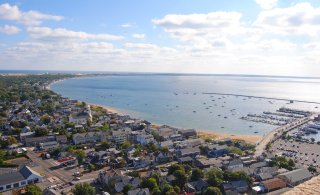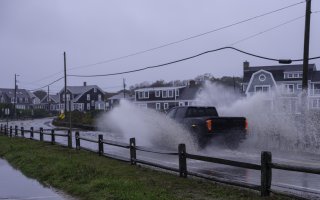Climate Change Connections: Massachusetts (Cape Cod)
Climate change is impacting all regions and sectors of the United States. The State and Regional Climate Change Connections resource highlights climate change connections to culturally, ecologically, or economically important features of each state and territory. The content on this page provides an illustrative example. As climate change will affect each state and territory in diverse ways, this resource only describes a small portion of these risks. For more comprehensive information about regional climate impacts, please visit the Fifth National Climate Assessment and Climate Change Impacts by Sector.
On this page:
Introduction: Cape Cod Culture and Economy

Cape Cod is home to over 230,000 year-round residents and welcomes millions of visitors every year.1 Vacationers flock to the region in the summer to enjoy the area’s natural beauty and explore its nearly 560 miles of coastline.2 During the warmer months, outdoor activities such as whale watching, golfing, fishing, and kayaking attract visitors to the Cape.2 Visitors also enjoy the Cape’s many sandy beaches, including those along the Cape Cod National Seashore, which receives about 4 million visitors annually.3
Cape Cod is home to artistic and cultural hotspots like Provincetown, the oldest continuous art colony in the United States and a notable destination for LGBTQ+ community members.4 These points of interest contribute to a strong seasonal tourism industry. In 2023, tourist spending along the Cape Cod National Seashore brought more than $700 million to the region and supported more than 9,600 local jobs.5 Cape Cod’s culture and history are deeply connected to the sea and coastal life, and the ocean economy is vital to the region. In 2020, Barnstable County, which includes all of Cape Cod, reeled in almost $35 million in revenue from fishing and aquaculture.6 In 2022, the commercial harvest and sale of eastern oysters, including Wellfleet’s famous oysters, and quahog clams in all of Massachusetts contributed nearly $70 million to the U.S. economy.7
Climate Impacts: Sea Level Rise Contributes to Erosion and Groundwater Contamination
Climate change is driving sea level rise around the globe. Warming temperatures cause sea level rise by melting land ice (such as glaciers and ice sheets) and heating ocean water, which makes it expand.8 Massachusetts experienced nearly 11 inches of sea level rise between 1921 and 2020.9 By 2100, the state could see 4 to 10 feet of sea level rise.9 Sea level rise will continue to increase coastal flooding and erosion along the Massachusetts coastline.9 Erosion threatens beaches, dunes, and wetlands; it also damages residences, historic structures, and roadways. Beach and wetlands losses and resulting diminished protection of coasts are expected to have major economic costs.10

Rising sea levels allow salt water to move farther inland, creating problems for human health and safety. When salt water infiltrates local groundwater supply, it raises the water table, causing flooding and threatening the freshwater supply stored in the aquifer below ground.11,12 In Cape Cod, this aquifer is the primary source of fresh water.13 When salt water enters the system and mixes with underground freshwater reserves, it reduces the quality of fresh water available and can contribute to flooding of below-grade infrastructure, such as basements and utilities. Studies have shown that the water table on Cape Cod could rise by almost 2 feet by 2100.14
Warming Ocean Temperatures Affect the Cape’s Seafood Industry
Climate change could affect many of the most beloved characteristics of Cape Cod. Warming temperatures, ocean acidification, coastal flooding, and erosion are projected to have far-reaching impacts on the Cape’s natural resources, built environment, and fishing and tourism industries. The temperature of the Atlantic Ocean around Cape Cod is warming at a rate three times faster than the global average, which could affect local marine life and the people who rely on ocean resources.15,16
Fisheries are particularly vulnerable to warming ocean temperatures. Many fish species migrate in response to seasonal temperature changes. Prolonged or extreme high temperatures can cause fish and shellfish species to move in search of cooler temperatures.17 Throughout the northeastern United States, there have been long-term observed shifts in the geographic ranges of many commercially and ecologically important species, such as American lobster and cod.12 These species are moving farther northeast and into deeper waters, reducing their availability for the local fishing industry and recreational anglers.

Warming waters can also increase the risks associated with eating seafood, especially raw seafood. A bacterial species of the genus Vibrio found in coastal waters around the Cape can cause vibriosis, a general term referring to a number of types of infections due to exposure to the different species of these bacteria. Consuming raw or undercooked seafood, including oysters, or exposing open cuts to contaminated water, are common sources of infection.18 Depending on the type of bacteria, vibriosis can cause symptoms including diarrhea, cramping, vomiting, severe skin infection, and rarely, gangrene and death, particularly in people with weakened immune systems.18 Vibriosis infections are expected to increase as a result of warming sea surface temperatures across the United States, including around Massachusetts.19
Taking Action: Protecting Marine Resources
Addressing climate change requires reducing greenhouse gas emissions while preparing for and protecting against current and future climate impacts. Communities, public officials, and individuals in every part of the United States can continue to explore and implement climate adaptation and mitigation measures. In Massachusetts, many organizations are taking steps to improve resilience of fisheries and protect coastlines, including:
- Sustainable fisheries Management. Organizations such as the Massachusetts Division of Marine Fisheries and the National Oceanic and Atmospheric Administration National Marine Fisheries Service (NOAA Fisheries) implement catch limits and season limits to manage fisheries and ensure that fish remain abundant.20 To support these efforts and the local fishing economy, seafood consumers can prioritize buying and eating local catch.
- Shoreline protection. Strategies for protecting shorelines from erosion include nature-based solutions, gray infrastructure for stormwater management, and mixes of the two. Shoreline adaptation and nature-based solutions can enhance the protective benefits of coastal ecosystems, such as salt marshes and eelgrass beds. The U.S. Environmental Protection Agency (EPA) collaborates with multiple agencies to research and support blue carbon initiatives that restore coastal eelgrass and marshes along the New England coast, which helps address sea level rise and remove carbon from the atmosphere.21 Conservation and restoration of these ecosystems not only helps buffer the shoreline from storm surges and wave damage, but can also boost the productivity of fisheries.
- Safeguarding freshwater resources. Cape Cod has launched multiple initiatives to protect their freshwater resources. The Cape Cod Freshwater Initiative aims to use monitoring and stakeholder engagement to analyze the quality of water throughout the Cape.22 Monitoring groundwater levels as they change with sea level rise will also help communities plan for flooding impacts. Tools like Cape Cod’s High Groundwater Levels Data Viewer inform residents and developers of how close groundwater is to the surface so that new septic systems and other projects are built in areas with lower flood risk.23
To learn more about climate change impacts in Massachusetts and the Northeast region, see Chapter 21 of the Fifth National Climate Assessment.
Related Resources
- EPA Climate Change Indicators: Sea Level
- EPA Climate Change Indicators: Sea Surface Temperature
- EPA Climate Change Indicators: Marine Species Distribution
- Massachusetts State Climate Summary 2022 (NOAA)
- ResilientMass (Massachusetts Executive Office of Energy and Environmental Affairs)
- Massachusetts Climate Change Assessment
- Massachusetts Integrated State Hazard Mitigation and Climate Adaptation Plan
- World of Change: Coastline Change (NASA)
References
1 U.S. Census Bureau. (2023). QuickFacts: Barnstable County, Massachusetts [Data set]. Retrieved July 5, 2024, from https://www.census.gov/quickfacts/barnstablecountymassachusetts
2 Cape Cod Chamber of Commerce. (n.d.). Cape Cod beaches. Retrieved June 12, 2023, from https://www.capecodchamber.org/things-to-do/beaches/
3 National Park Service. (n.d.). Tourism to Cape Cod National Seashore contributes $750 million to local economy. Cape Cod National Seashore. Retrieved July 5, 2024, from https://www.nps.gov/caco/learn/news/tourism-to-cape-cod-national-seashore-contributes-750-million-to-local-economy.htm
4 Town of Provincetown. (2023). Sociodemographic survey of town staff and town board/committee members. https://www.provincetown-ma.gov/DocumentCenter/View/16571/Report_SociodemographicSurvey_July2023
5 Cape Cod Chamber of Commerce. (n.d.). Statistics. Retrieved June 6, 2023, from https://www.capecodchamber.org/members/membership/statistics/
6 NOAA Office for Coastal Management. (n.d.). ENOW explorer: Barnstable County, Massachusetts. Retrieved December 8, 2023, from https://coast.noaa.gov/enowexplorer/#/employment/livingresources/2020/25001
7 NOAA Fisheries. (2023). Landings (3.16.0.7) [Data set]. Retrieved November 29, 2023, from https://www.fisheries.noaa.gov/foss/f?p=215:200:15239389896888:::::
8 Leung, L. R., Terando, A., Joseph, R., Tselioudis, G., Bruhwiler, L. M., Cook, B., Deser, C., Hall, A., Hamlington, B. D., Hoell, A., Hoffman, F. M., Klein, S., Naik, V., Pendergrass, A. G., Tebaldi, C., Ullrich, P. A., & Wehner, M. F. (2023). Ch. 3. Earth systems processes. In A. R. Crimmins, C. W. Avery, D. R. Easterling, K. E. Kunkel, B. C. Stewart, & T. K. Maycock (Eds.), Fifth National Climate Assessment. U.S. Global Change Research Program. https://doi.org/10.7930/NCA5.2023.CH3
9 Runkle, J., Kunkel, K. E., Frankson, R., Easterling, D. R., DeGaetano, A. T., Stewart, B. C., Sweet, W., & Spaccio, J. (2022). Massachusetts state climate summary 2022 (NOAA Technical Report NESDIS 150-MA). NOAA National Environmental Satellite, Data, and Information Service. https://statesummaries.ncics.org/chapter/ma/
10 Fant, C., Gentile, L. E., Herold, N., Kunkle, H., Kerrich, Z., Neumann, J., & Martinich, J. (2022). Valuation of long-term coastal wetland changes in the U.S. Ocean & Coastal Management, 226, 106248. https://doi.org/10.1016/j.ocecoaman.2022.106248
11 Masterson, J. P., & Garabedian, S. P. (2007). Effects of Sea‐Level Rise on Ground Water Flow in a Coastal Aquifer System. Groundwater, 45(2), 209–217. https://doi.org/10.1111/j.1745-6584.2006.00279.x
12 May, C. L., Osler, M. S., Stockdon, H. F., Barnard, P. L., Callahan, J. A., Collini, R. C., Ferreira, C. M., Finzi Hart, J., Lentz, E. E., Mahoney, T. B., Sweet, W., Walker, D., & Weaver, C. P. (2023). Ch. 9. Coastal effects. In A. R. Crimmins, C. W. Avery, D. R. Easterling, K. E. Kunkel, B. C. Stewart, & T. K. Maycock (Eds.), Fifth National Climate Assessment. U.S. Global Change Research Program. https://doi.org/10.7930/NCA5.2023.CH9
13 National Park Service. (n.d.). Groundwater. Cape Cod National Seashore. Retrieved February 23, 2024, from https://www.nps.gov/caco/learn/nature/groundwater.htm
14 U.S. Geological Survey. (2016). Cape Cod susceptible to potential effects of sea-level rise. Retrieved February 23, 2024, from https://www.usgs.gov/news/state-news-release/cape-cod-susceptible-potential-effects-sea-level-rise
15 Saba, V. S., Griffies, S. M., Anderson, W. G., Winton, M., Alexander, M. A., Delworth, T. L., Hare, J. A., Harrison, M. J., Rosati, A., Vecchi, G. A., & Zhang, R. (2016). Enhanced warming of the northwest Atlantic Ocean under climate change. Journal of Geophysical Research: Oceans, 121(1), 118–132. https://doi.org/10.1002/2015JC011346
16 EPA. (2023). Climate change indicators: Marine species distribution. Retrieved June 12, 2023, from https://www.epa.gov/climate-indicators/climate-change-indicators-marine-species-distribution
17 NOAA Fisheries. (2023). State of the ecosystem 2023: New England. Northeast Fisheries Science Center (U.S.). https://repository.library.noaa.gov/view/noaa/49706
18 Baker-Austin, C., Oliver, J. D., Alam, M., Ali, A., Waldor, M. K., Qadri, F., & Martinez-Urtaza, J. (2018). Vibrio spp. infections. Nature Reviews Disease Primers, 4(1), 1–19. https://doi.org/10.1038/s41572-018-0005-8
19 Sheahan, M., Gould, C. A., Neumann, J. E., Kinney, P. L., Hoffmann, S., Fant, C., Wang, X., & Kolian, M. (2022). Examining the relationship between climate change and vibriosis in the United States: Projected health and economic impacts for the 21st century. Environmental Health Perspectives, 130(8). https://doi.org/10.1289/EHP9999a
20 Division of Marine Fisheries. (2024). Current commercial fishing quotas and landings. Mass.gov. Retrieved May 10, 2024, from https://www.mass.gov/info-details/current-commercial-fishing-quotas-and-landings
21 EPA. (n.d.). Blue Carbon in New England. Climate Change: Resilience and Adaptation in New England (RAINE). Retrieved September 16, 2024, from https://www.epa.gov/raine/blue-carbon-new-england
22 Cape Cod Commission. (n.d.). Cape Cod Freshwater Initiative. Retrieved February 23, 2024, from https://www.capecodcommission.org/our-work/cape-cod-freshwater-initiative/
23 Cape Cod Commission. (n.d.). Estimating high groundwater levels. Retrieved February 23, 2024, from https://www.capecodcommission.org/our-work/estimating-high-groundwater-levels/

